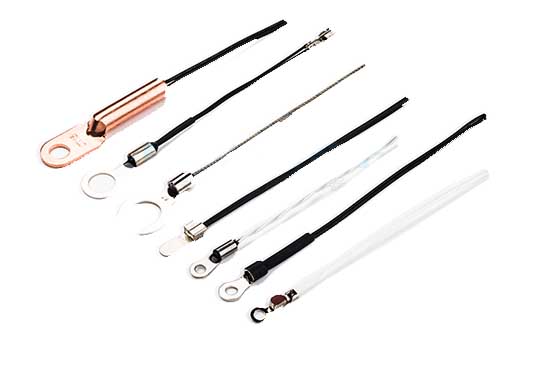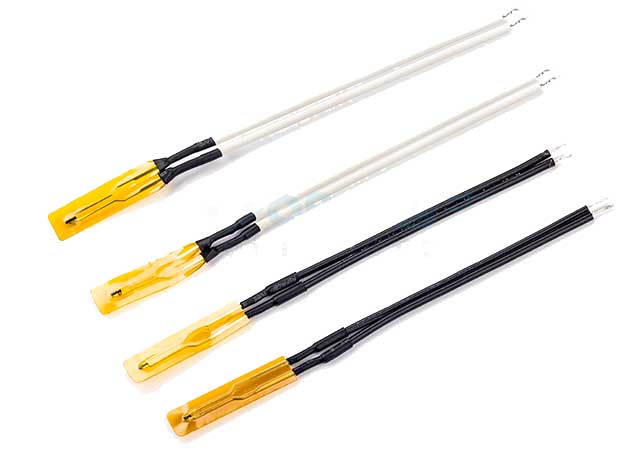Temperature Sensor for Lithium Battery
Commonly used temperature sensors for lithium battery components are as follows:
Temperature sensor for battery cell interconnection board detection; battery pack end plate temperature detection; battery pack busbar temperature detection; battery internal temperature measurement; automotive battery pack temperature detection; battery body temperature sensor; battery cell surface temperature detection.

Product advantages
Installed in the cells of energy storage products or on the busbar of battery packs, it is used for multi-point temperature detection of cells or battery packs;
A variety of installation structures and sizes are available;
Strong moisture resistance, high stability and high pressure resistance.
Product parameters
NTC single-ended glass-sealed resistor/PT100/1000 platinum resistor (can be customized)
Application occasions
New energy vehicle energy storage and battery pack
[Question 1] "If the temperature sensor in the power battery pack is damaged, what impact will it have on the BMS?"
Let’s look at four situations:
1. Unable to output signal + only one temperature sensor.
2. The output signal is incorrect + there is only one temperature sensor.
3. Unable to output signal + there are temperature sensors elsewhere in the entire package.
4. The output signal is incorrect + there are temperature sensors elsewhere in the entire package.
In situations 1, 3, and 4, the BMS battery management system can detect sensor problems and initiate emergency procedures. When the system cannot solve the problem, it will first alarm and then cut off the power. Situation 2 is more troublesome and generally occurs in low-cost package solutions.
If there is a problem with temperature monitoring, lithium precipitation in the battery at low temperatures will puncture the diaphragm, causing an internal short circuit and thermal runaway. Severe high temperatures can lead to explosions.
The BMS battery management system itself passively receives sensor data, performs calculations according to the preset program, and then issues control instructions. In the case of incorrect output signal + only one temperature sensor, the data output of the only temperature sensor is incorrect, and BMS can only make wrong judgments based on the wrong data and issue wrong control instructions: If the output data exceeds the threshold BMS Will call the police. On the contrary, if the threshold is not exceeded, it will continue to work, and the threat will always be potential.
Temperature sensor for BMS battery management system
[Question 2] "What is the function of the battery temperature sensor?"
Detect the battery temperature. When the battery temperature is too high during charging, the charging current will be reduced or stopped to protect the battery.
[Question 3] At what temperature will lithium batteries spontaneously ignite? What is the operating temperature range?
Generally speaking, the diaphragm will begin to fail at around 130°C, and then thermal runaway will occur. If it is controlled within 100°C, there will be no abnormalities, let alone spontaneous combustion. But, don’t generalize! Because the high-temperature failure of lithium batteries depends on the melting of the separator, the melting of the separator will cause the positive and negative electrodes to short-circuit and cause failure. For lithium batteries, generally N/P is relatively high, and the corresponding negative electrode charge is relatively low. Usually, only smoke is emitted during the entire failure process, and no fire occurs. However, when the temperature rises to about 160°C, it will suddenly fail and start burning.
 [Question 4] “In addition to using the original lithium battery pack charger in summer, what other precautions should be taken?”
[Question 4] “In addition to using the original lithium battery pack charger in summer, what other precautions should be taken?”
1. Do not charge in high temperature environment
Lithium battery packs will be overcharged when operating during high temperature seasons. The increase in temperature will increase the activity of each active material, and the reaction will be sufficient and intense, resulting in fast reaction speed, high charging current and high temperature during charging, and lower charging voltage required during charging. Try to use the original lithium battery pack charger for charging. The original charger has strong supporting performance and a moderate charging rate.
2. Do not expose yourself to the hot sun
The weather is hot, and the battery of an electric vehicle is constantly generating heat during use, so the safety hazard of the battery will be greater, and it is more likely to cause the battery to spontaneously ignite. At this time, pay attention to the ventilation and heat dissipation of the battery to prevent the electric vehicle battery from being exposed to the sun.
3. Do not let water enter the battery
Water entering the battery may directly cause a short circuit between the positive and negative poles. The mildest consequence: damage to the battery, the most serious consequence: battery short circuit, burning or even explosion.
4. Under the guidance of technical installation
Lithium battery pack installation should be carried out with the assistance of technical guidance or professionals.
5. Don’t store electricity empty
Lithium battery packs are not allowed to be stored without power. If the lithium battery pack is not suitable for short-term use, please charge the battery to more than 50% for storage and charge it once a month.
6. Do not charge immediately after use. "Charge immediately after use so that it can be used next time."
This is wrong. The temperature of the equipment is very high after operating in a high temperature state. At this time, if the battery is charged vertically, the temperature of the battery will continue to increase, even exceeding the critical point and causing spontaneous combustion.
7. Do not use the charger indiscriminately
All tram batteries are compatible. Different batteries have different charger compatibility. Mixed use may cause short circuit or insufficient charging. Do not use the charger indiscriminately, which not only causes great harm to the battery, but also creates hidden dangers for safety.
Temperature sensor for battery cell interconnection board detection; battery pack end plate temperature detection; battery pack busbar temperature detection; battery internal temperature measurement; automotive battery pack temperature detection; battery body temperature sensor; battery cell surface temperature detection.

Product advantages
Installed in the cells of energy storage products or on the busbar of battery packs, it is used for multi-point temperature detection of cells or battery packs;
A variety of installation structures and sizes are available;
Strong moisture resistance, high stability and high pressure resistance.
Product parameters
NTC single-ended glass-sealed resistor/PT100/1000 platinum resistor (can be customized)
Application occasions
New energy vehicle energy storage and battery pack
[Question 1] "If the temperature sensor in the power battery pack is damaged, what impact will it have on the BMS?"
Let’s look at four situations:
1. Unable to output signal + only one temperature sensor.
2. The output signal is incorrect + there is only one temperature sensor.
3. Unable to output signal + there are temperature sensors elsewhere in the entire package.
4. The output signal is incorrect + there are temperature sensors elsewhere in the entire package.
In situations 1, 3, and 4, the BMS battery management system can detect sensor problems and initiate emergency procedures. When the system cannot solve the problem, it will first alarm and then cut off the power. Situation 2 is more troublesome and generally occurs in low-cost package solutions.
If there is a problem with temperature monitoring, lithium precipitation in the battery at low temperatures will puncture the diaphragm, causing an internal short circuit and thermal runaway. Severe high temperatures can lead to explosions.
The BMS battery management system itself passively receives sensor data, performs calculations according to the preset program, and then issues control instructions. In the case of incorrect output signal + only one temperature sensor, the data output of the only temperature sensor is incorrect, and BMS can only make wrong judgments based on the wrong data and issue wrong control instructions: If the output data exceeds the threshold BMS Will call the police. On the contrary, if the threshold is not exceeded, it will continue to work, and the threat will always be potential.
Temperature sensor for BMS battery management system
[Question 2] "What is the function of the battery temperature sensor?"
Detect the battery temperature. When the battery temperature is too high during charging, the charging current will be reduced or stopped to protect the battery.
[Question 3] At what temperature will lithium batteries spontaneously ignite? What is the operating temperature range?
Generally speaking, the diaphragm will begin to fail at around 130°C, and then thermal runaway will occur. If it is controlled within 100°C, there will be no abnormalities, let alone spontaneous combustion. But, don’t generalize! Because the high-temperature failure of lithium batteries depends on the melting of the separator, the melting of the separator will cause the positive and negative electrodes to short-circuit and cause failure. For lithium batteries, generally N/P is relatively high, and the corresponding negative electrode charge is relatively low. Usually, only smoke is emitted during the entire failure process, and no fire occurs. However, when the temperature rises to about 160°C, it will suddenly fail and start burning.

1. Do not charge in high temperature environment
Lithium battery packs will be overcharged when operating during high temperature seasons. The increase in temperature will increase the activity of each active material, and the reaction will be sufficient and intense, resulting in fast reaction speed, high charging current and high temperature during charging, and lower charging voltage required during charging. Try to use the original lithium battery pack charger for charging. The original charger has strong supporting performance and a moderate charging rate.
2. Do not expose yourself to the hot sun
The weather is hot, and the battery of an electric vehicle is constantly generating heat during use, so the safety hazard of the battery will be greater, and it is more likely to cause the battery to spontaneously ignite. At this time, pay attention to the ventilation and heat dissipation of the battery to prevent the electric vehicle battery from being exposed to the sun.
3. Do not let water enter the battery
Water entering the battery may directly cause a short circuit between the positive and negative poles. The mildest consequence: damage to the battery, the most serious consequence: battery short circuit, burning or even explosion.
4. Under the guidance of technical installation
Lithium battery pack installation should be carried out with the assistance of technical guidance or professionals.
5. Don’t store electricity empty
Lithium battery packs are not allowed to be stored without power. If the lithium battery pack is not suitable for short-term use, please charge the battery to more than 50% for storage and charge it once a month.
6. Do not charge immediately after use. "Charge immediately after use so that it can be used next time."
This is wrong. The temperature of the equipment is very high after operating in a high temperature state. At this time, if the battery is charged vertically, the temperature of the battery will continue to increase, even exceeding the critical point and causing spontaneous combustion.
7. Do not use the charger indiscriminately
All tram batteries are compatible. Different batteries have different charger compatibility. Mixed use may cause short circuit or insufficient charging. Do not use the charger indiscriminately, which not only causes great harm to the battery, but also creates hidden dangers for safety.





